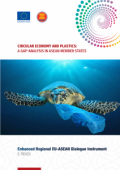The resource, Implementing Solutions to Climate Change and Air Pollution in Asia: Mobilising Finance, Strengthening Policies and Building Capacities (White Paper 2020), focuses on three areas to advances science based solutions to advance knowledge sharing and awareness related to co-benefits, which are defined as the multiple benefits from actions that mitigate climate change while meeting other sustainable development priorities.

The resource, Decarbonization Pathways and Energy Investment needs for developing Asia in line with ‘well below’ 2°C, explores potential future pathways for developing Asia’s energy consumption, CO2 emissions and infrastructure investment to enable countries to accomplish the global climate targets set out in the 2015 Paris Agreement.
This working paper analyses the nationally determined contributions (NDCs) of the Asian Development Bank’s developing member countries. It focuses on the intent and preparedness of member countries to use market mechanisms in achieving targets set out in their NDCs.

Preventing and reducing plastic pollution is about more than waste management. This report applies a circular economy perspective to plastics and presents frameworks for addressing related sustainability challenges. A shift to a circular economy will require coordinated policy interventions at all stages of the life-cycle of plastics, including: resource extraction and refining, design and manufacture of products, trade and retail, use and reuse, recycling, and final disposal when necessary.
While plastic pollution is a global problem, around 60 percent of marine plastic debris enters the ocean from just five countries: China, Indonesia, Thailand, Vietnam, and the Philippines. This report focuses on the challenge of managing plastic packaging waste in Southeast Asia and China. In addition to showing the scale of the challenge, the report gives an idea of the funds that could be raised if these countries introduced extended producer responsibility (EPR) schemes, under which companies that place plastic packaging on the market cover the costs of its proper management—from collection and sorting to recycling and disposal.
